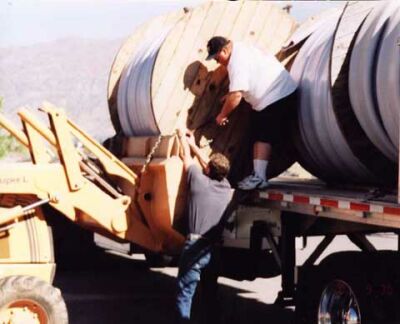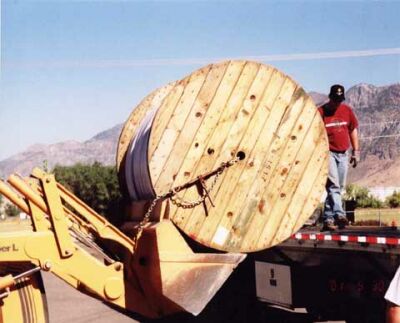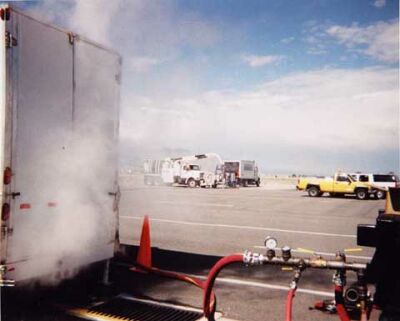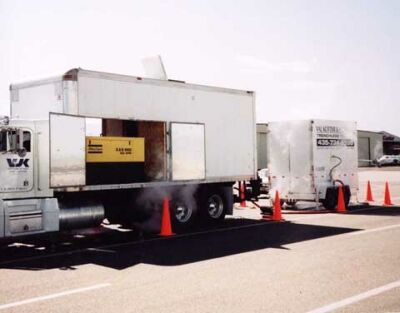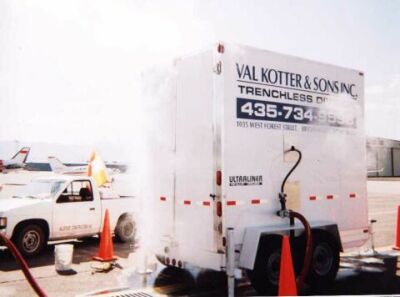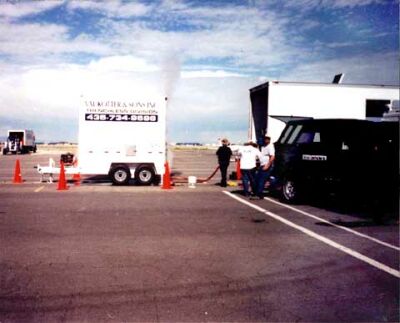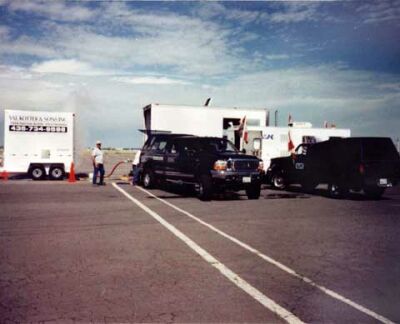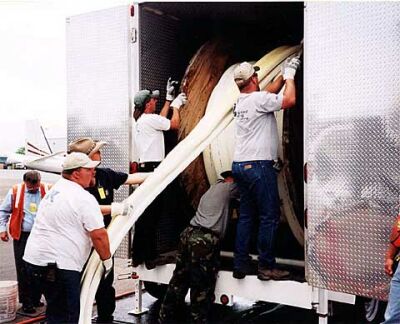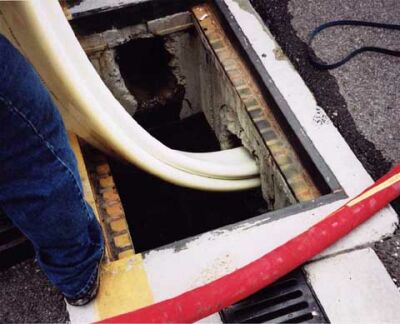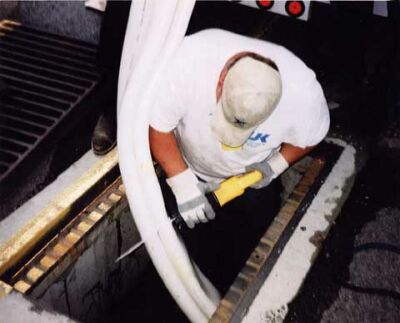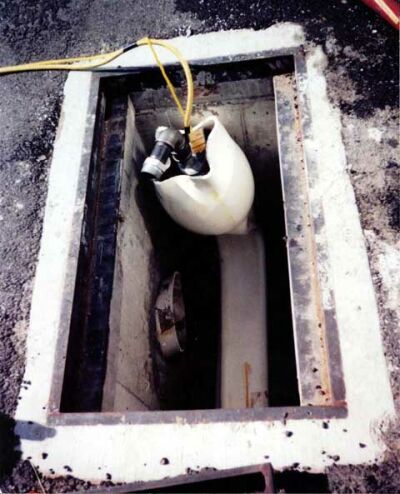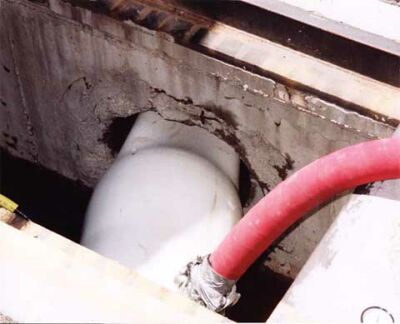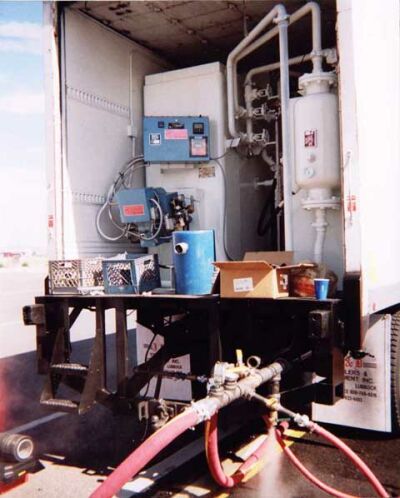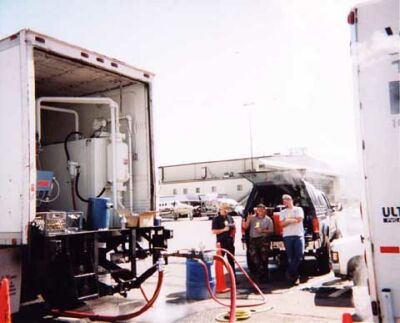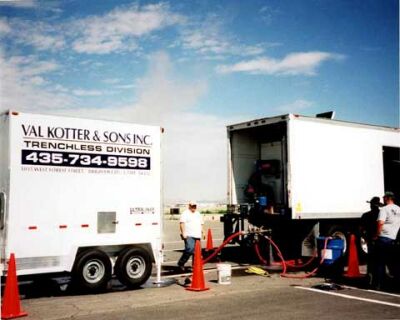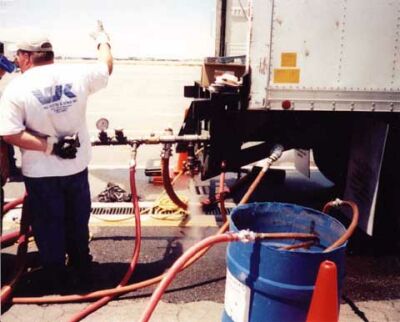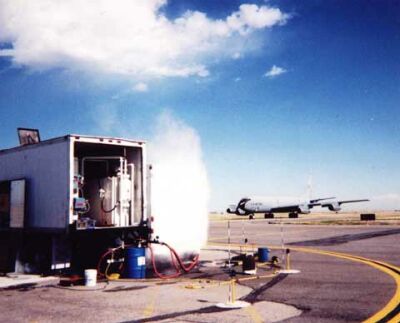Val Kotter & Sons Salt Lake City Airport Project using UltraLiner™
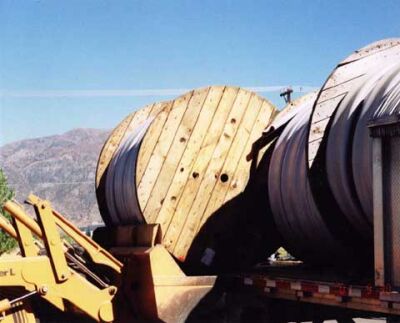
Rehab Solution Under SLC Airport
Most airports which experience freezing weather use an ethylene glycol spray to de-ice aircraft. They also have a system to collect and recover the waste glycol. Salt Lake City International Airport uses a series of de-icing pads which are located along the airport taxiways. Channels in the general aviation de-icing pad direct waste glycol and melted ice and snow to a catch basin and into a 15-inch diameter concrete pipeline which empties into a central vault. When the vault is full, the waste solution is pumped into a truck and transported to a glycol recovery plant which separates the glycol for reuse, and allows the glycol-free water to be released into the city's sewer system.
The waste glycol recovery system is very expensive to operate, so when groundwater began to infiltrate the piping system, the increased transportation and separation costs were quickly noticed.
Robert Markham, project engineer, Salt Lake City Department of Airports, had been specifying HDPE
slip lining to seal the groundwater out of the 15-inch gravity lines, but this process required pits to be dug on the airfield. The pits created operational problems and safety hazards during the two weeks it took to
slip line each pipeline section. Markham began to search for a lining process which would not require digging, and discovered Ultraliner PVC Alloy
Pipe liner. He decided to use the process on two of the glycol recovery lines. One line was 151-feet long and the other was 166 feet.
Ultraliner is made of a special PVC Alloy which gives the finished pipe its unique characteristics. The
pipe liner is flattened during the manufacturing process to reduce its cross-sectional area so it can be pulled through a host pipe easily. Once the pipe has been properly placed in the pipeline, it is heated to a prescribed temperature. Then, air pressure expands the liner and presses it tightly against the wall of the host pipe. The pipe is then cooled. When the ends are trimmed off, the rehabilitated pipe can be returned to service.
While ordinary thermoplastics have a "memory" which causes them to "creep" back toward their original manufactured size and shape, Ultraliner's special compound and "blow-mold" installation process allows its "memory" to be reset to its new, expanded shape and size. As a result, once the liner has been installed, it will not shrink away from the host pipe.
In addition to its high degree of dimensional stability, the finished pipe liner
has independent structural integrity, high impact strength and the ability to relieve high levels of stress without structurally compromising the material.
Installation process
Val Kotter, owner of Val Kotter & Sons Inc., Brigham City, UT, the Ultraliner installer contracted to rehabilitate the two lines, explained the installation process.
A boiler truck and a special trailer for the Ultraliner PVC Alloy Pipe liner
reel were positioned at one end of the pipeline, and a constant-pressure winch was at the other. While the pipeline was being cleaned and televised, a steam line was connected between the boiler truck and reel trailer to heat the liner and cause it to be very flexible.
When the liner reached a prescribed temperature, a hole was drilled through the end of the flattened liner so it could be connected to the winch line. At that point, the liner was pulled through the host pipe by the winch and allowed to protrude a few feet on both ends.
Both ends of the liner were opened by hand, and inflatable, flow-through plugs were inserted. The plugs are specially designed so they can withstand the heat and low air pressure during processing. The plugs also caused the ends of the liner to flare slightly at the ends of the pipeline, thus sealing the liner to the pipe.
Steam was passed through the liner to raise it to the prescribed temperature before pressurized air was introduced to expand the liner and press it tightly against the host pipe. The combination of specified temperatures, air pressure and the special alloy material, molds the liner to the shape of the host pipe and resets its memory so it will permanently hold its new shape. The tight fit and molded shape mechanically "lock" the liner in the host pipe so it cannot move.
Special challenges
The catch basins at the ends of the pipe sections were smaller than normal manholes, so access to the 15-inch pipes was very limited. "We felt we could line both pipelines in one day, but since access was so limited, we decided to allocate a day for each pipe," Kotter said. "However, the alloy liner is so flexible, we were able to go through the catch basins into the pipe with no problem."
A leaking joint was discovered near the end of one of the pipes, so it was
pressure sealed with 3M chemical grout before the lining began. Special care also had to be taken because the taxiways remained open during the installation process.
The ambient temperature on the airfield also presented a temporary challenge. The temperature of the ambient air coming out of the air compressor was 120 degrees and it was necessary to lower the temperature inside the liner after installation to a minimum of 80 degrees to ensure that its memory would be reset to its new form.
In addition to the normal training Kotter and his crew received at Ultraliner headquarters in Oxford, AL, two Ultraliner field service representatives flew to Salt Lake City to be present in case they were needed during the installation. "As it turned out, we really weren't needed," said Sam McLean, field service manager, Ultraliner. "Kotter's was the most well-prepared, well-supervised and well-motivated crew that I have worked with. Their professionalism is outstanding."
"If you have the right equipment, and you're properly trained, Ultraliner is an easy process," Kotter says. "I have good men who work with me, and we take a lot of pride in
what we do. We were ready for Sam and his assistant, Chris, when they got
here
Results
After the installation process was completed on both pipes, they were
inspected using a remote controlled TV. Kotter said the liners looked
perfect from one catch basin to the next. "Just a perfect pipe
without any joints" he said.
Markham agreed that the liners looked perfect, but the final results will not be known until this winter when the system is fully operational. During the summer season, closed gates prevent water from entering the storage vault. "I expect it to work perfectly" Markham says. "Right now, I know that it went in quickly and no pits were dug. That's a significant benefit to any airport."
Reprinted From Rehabilitation Technology • www.undergroundconstructiononline.com November 2001
